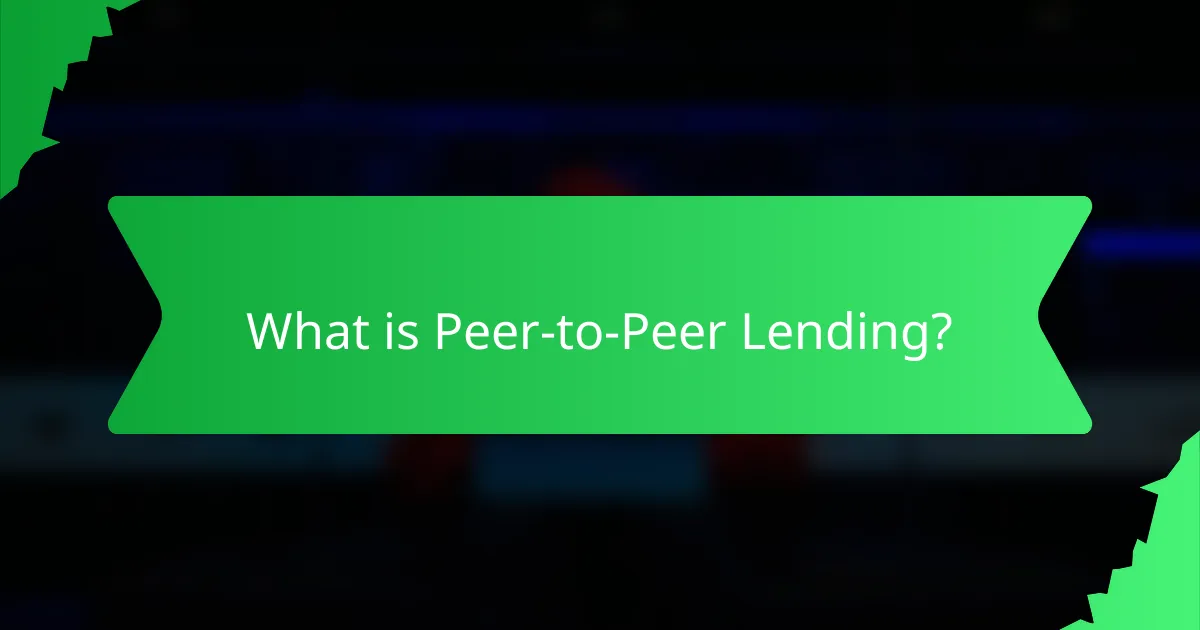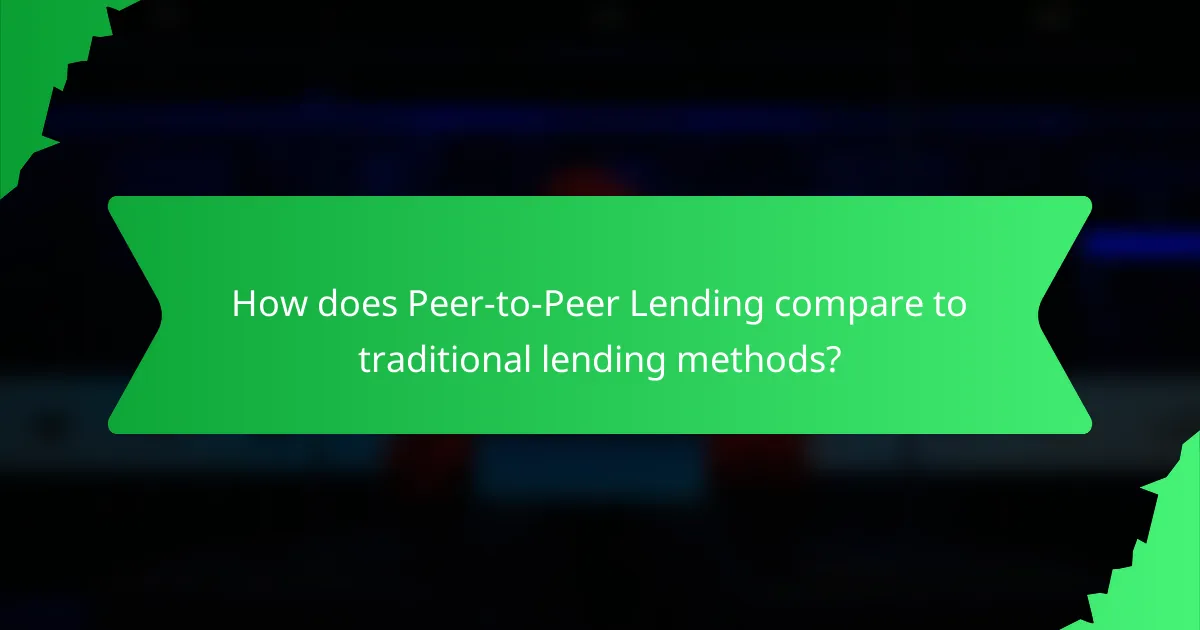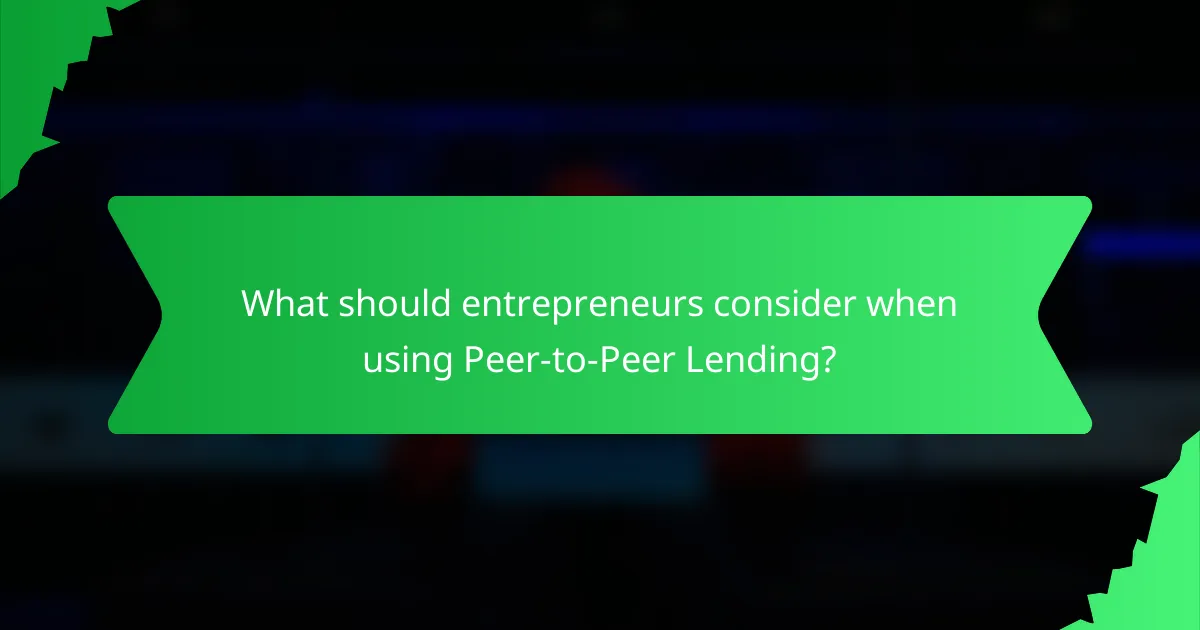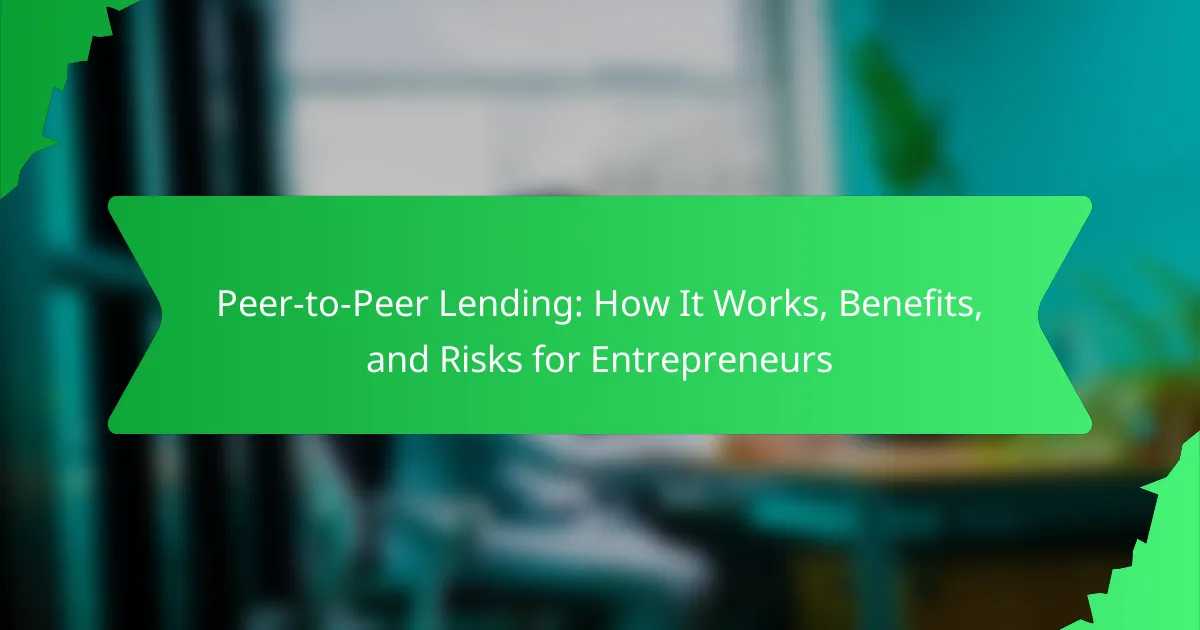Peer-to-peer (P2P) lending is a financial model that facilitates direct borrowing and lending between individuals through online platforms, bypassing traditional banks. This article explores how P2P lending works, highlighting its benefits such as lower interest rates, quicker application processes, and flexibility in repayment terms. It also addresses the risks involved, including higher default rates and varying creditworthiness assessments. Entrepreneurs will find essential information on evaluating interest rates, fees, and loan terms, as well as the importance of understanding platform policies and potential impacts on credit scores.

What is Peer-to-Peer Lending?
Peer-to-peer lending is a method of borrowing and lending money directly between individuals without traditional financial institutions. This process typically occurs through online platforms that connect borrowers and lenders. Borrowers can access funds for various purposes, such as personal loans or business financing. Lenders earn interest on the money they provide. According to a report by the Cambridge Centre for Alternative Finance, the global peer-to-peer lending market reached approximately $67 billion in 2020. This indicates significant growth and acceptance of this financial model.
How does Peer-to-Peer Lending operate?
Peer-to-Peer (P2P) Lending operates by connecting borrowers directly with individual lenders through online platforms. These platforms allow borrowers to present their loan requests and financial profiles. Lenders can review these requests and choose to fund them partially or fully. The process eliminates traditional financial institutions as intermediaries. Borrowers typically pay interest on the loans, which is distributed to the lenders. P2P lending platforms often charge fees for their services. The loans can range from personal loans to business financing. According to a 2021 report, the global P2P lending market was valued at approximately $67 billion. This growth indicates the increasing popularity of direct lending models among consumers and investors.
What are the key components of Peer-to-Peer Lending?
The key components of Peer-to-Peer Lending include the platform, borrowers, and investors. The platform facilitates the connection between borrowers and investors. Borrowers seek loans for various purposes, such as personal or business needs. Investors provide funds to borrowers in exchange for interest payments. The platform typically charges fees for its services, which can affect the overall cost of borrowing. Credit assessments are conducted to evaluate the borrower’s risk profile. Loan terms, including interest rates and repayment schedules, are defined during the process. According to a report by the Cambridge Centre for Alternative Finance, the global P2P lending market reached $67 billion in 2020, highlighting its significance in the financial landscape.
How do lenders and borrowers connect in Peer-to-Peer Lending?
Lenders and borrowers connect in Peer-to-Peer (P2P) lending through online platforms. These platforms facilitate the matching of individuals seeking loans with those willing to lend money. Borrowers submit loan requests, detailing the amount needed and purpose. Lenders review these requests and can choose to fund them partially or fully. The platforms often provide credit assessments and risk evaluations to help lenders make informed decisions. Communication between lenders and borrowers may occur through the platform, ensuring privacy and security. Transactions are typically managed by the platform, which collects payments and distributes them to lenders. This model allows for direct financial interaction without traditional banks acting as intermediaries.
What are the main benefits of Peer-to-Peer Lending for entrepreneurs?
Peer-to-Peer (P2P) lending offers several benefits for entrepreneurs. First, it provides access to capital without traditional banking requirements. Entrepreneurs can secure funding quickly, often with less paperwork. P2P lending platforms typically have lower interest rates compared to conventional loans. This can lead to significant cost savings for businesses. Additionally, P2P lending allows entrepreneurs to connect directly with investors. This connection can foster a sense of community and support. Furthermore, P2P lending can improve credit scores if repayments are made on time. This can open doors for future financing opportunities. Overall, P2P lending presents a flexible and efficient funding option for entrepreneurs.
How does Peer-to-Peer Lending provide access to capital?
Peer-to-Peer Lending provides access to capital by connecting borrowers directly with individual lenders. This model eliminates traditional financial institutions as intermediaries. Borrowers can present their funding needs on online platforms. Lenders can then choose which loans to fund based on their preferences. This process often results in lower interest rates for borrowers. It also allows lenders to earn higher returns compared to traditional savings accounts. According to a report by the Cambridge Centre for Alternative Finance, P2P lending has grown significantly, facilitating billions in loans globally. This growth demonstrates its effectiveness in providing accessible capital to a diverse range of borrowers.
What are the competitive advantages of Peer-to-Peer Lending over traditional financing?
Peer-to-Peer (P2P) Lending offers several competitive advantages over traditional financing. P2P platforms typically provide lower interest rates compared to banks. This is due to reduced overhead costs and the absence of intermediaries. Borrowers can access funds more quickly, often within days, whereas traditional loans may take weeks. P2P lending also allows for more flexible repayment terms tailored to individual needs. It provides access to credit for underserved borrowers who may not qualify for traditional loans. Additionally, P2P platforms often have a more straightforward application process. According to a study by the Cambridge Centre for Alternative Finance, P2P lending has grown significantly, indicating its increasing acceptance and reliability.
What risks should entrepreneurs be aware of in Peer-to-Peer Lending?
Entrepreneurs should be aware of several risks in Peer-to-Peer Lending. Default risk is significant; borrowers may fail to repay loans. According to a study by the Cambridge Centre for Alternative Finance, default rates can range from 1% to over 10%. Interest rate risk is another concern; fluctuating rates can impact loan profitability. Additionally, regulatory risk exists; changes in laws can affect P2P platforms’ operations. Market risk is also relevant; economic downturns can lead to increased defaults. Finally, platform risk must be considered; the financial health of the P2P platform can influence loan security.
What potential challenges do borrowers face in Peer-to-Peer Lending?
Borrowers in Peer-to-Peer (P2P) lending face several potential challenges. One significant challenge is the risk of high interest rates. Interest rates can vary widely depending on the borrower’s creditworthiness. Borrowers with lower credit scores may face rates that exceed traditional loans. Another challenge is the potential for limited funding availability. Not all loan requests receive the necessary funding from investors. This can lead to delays or the inability to secure needed capital. Additionally, borrowers may encounter a lack of regulatory oversight. P2P lending platforms are not always subject to the same regulations as traditional lenders. This can create uncertainty regarding borrower rights and protections. Lastly, borrowers may face difficulties in understanding the terms and conditions. Complex loan agreements can lead to misunderstandings about repayment obligations.
How can lenders mitigate risks in Peer-to-Peer Lending?
Lenders can mitigate risks in Peer-to-Peer Lending by diversifying their investments across multiple loans. This strategy reduces the impact of a single default on their overall portfolio. Lenders should also assess borrower creditworthiness using credit scores and financial history. Conducting thorough due diligence helps identify reliable borrowers. Implementing risk assessment tools and platforms can enhance decision-making. Lenders may also set maximum investment limits per loan to manage exposure. Regularly reviewing loan performance and market trends allows lenders to adjust strategies as needed. These practices collectively help maintain a balanced risk profile in Peer-to-Peer Lending.

How does Peer-to-Peer Lending compare to traditional lending methods?
Peer-to-Peer (P2P) lending offers a direct connection between borrowers and individual lenders. Traditional lending methods involve banks or financial institutions acting as intermediaries. P2P lending typically features lower interest rates due to reduced overhead costs. In contrast, traditional lenders may charge higher rates to cover operational expenses.
The application process for P2P lending is often quicker and more streamlined. Traditional lending can involve lengthy paperwork and approval times. P2P platforms usually provide a user-friendly online experience. Traditional lenders may require in-person visits and extensive documentation.
Default rates in P2P lending can be higher, as borrowers may have less stringent credit checks. Traditional lenders often have more rigorous assessment processes. P2P lending allows for smaller loan amounts, catering to niche needs. Traditional loans generally require larger sums.
P2P lending can offer greater flexibility in repayment terms. Traditional lenders typically have set repayment schedules. Overall, P2P lending provides an alternative to traditional lending, with unique advantages and risks.
What are the differences between Peer-to-Peer Lending and bank loans?
Peer-to-Peer (P2P) lending and bank loans differ primarily in their funding sources. P2P lending connects borrowers directly with individual investors through online platforms. Bank loans are funded by the bank’s capital and deposits from customers.
The application process for P2P loans is often faster and more streamlined than traditional bank loans. P2P platforms typically have less stringent credit requirements compared to banks. Interest rates on P2P loans can vary widely, influenced by borrower risk profiles and investor demand. In contrast, bank loans often have fixed rates determined by the bank’s policies.
P2P lending usually involves lower fees compared to traditional banks. Additionally, P2P platforms may offer more flexible repayment terms. Banks, however, provide greater regulatory oversight and consumer protections.
Data from the Peer-to-Peer Finance Association indicates that P2P lending has grown significantly, reaching billions in loans issued annually. This growth reflects the increasing popularity of alternative lending options among borrowers.
How do interest rates differ between Peer-to-Peer Lending and traditional banks?
Interest rates in Peer-to-Peer (P2P) Lending are typically higher than those offered by traditional banks. P2P platforms often charge borrowers between 5% to 36% interest rates, depending on creditworthiness. In contrast, traditional banks usually offer lower rates, averaging around 3% to 10% for similar loans. The difference arises because P2P lending involves less overhead and fewer regulatory costs. However, P2P lenders may also assess risk differently, leading to higher rates for borrowers with lower credit scores. This structure allows P2P platforms to attract investors seeking higher returns, which can influence the rates offered.
What are the approval processes like for Peer-to-Peer Lending versus traditional loans?
The approval process for Peer-to-Peer (P2P) lending is generally faster and more streamlined than that of traditional loans. P2P lending platforms utilize online technology to assess borrower information quickly. This often results in approval times of just a few hours to a few days. In contrast, traditional loans usually involve a more lengthy process, often taking several weeks. Traditional lenders require extensive documentation and a thorough credit check. They also consider factors such as employment history and income stability. P2P platforms may focus more on credit scores and less on personal financial history. According to a study by the Cambridge Centre for Alternative Finance, P2P lending can cut approval times by up to 50% compared to traditional banks. This efficiency makes P2P lending attractive for borrowers seeking quick access to funds.
What types of entrepreneurs benefit most from Peer-to-Peer Lending?
Small business owners and startups benefit most from Peer-to-Peer Lending. These entrepreneurs often face challenges in securing traditional bank loans. Peer-to-Peer Lending platforms provide accessible funding options. They typically offer lower interest rates than credit cards. Additionally, these platforms can facilitate quicker approval processes. Entrepreneurs with limited credit histories may find this option particularly advantageous. According to a study by the Cambridge Centre for Alternative Finance, small businesses are a significant segment of Peer-to-Peer Lending borrowers. This indicates a strong alignment between the needs of small businesses and the offerings of Peer-to-Peer platforms.
How does Peer-to-Peer Lending cater to startups and small businesses?
Peer-to-Peer Lending provides startups and small businesses with access to funding. It connects borrowers directly with individual lenders through online platforms. This model reduces reliance on traditional banks, which often impose stringent lending criteria. Startups can obtain loans quickly, often with less paperwork and faster approval times. Interest rates may be competitive compared to conventional loans. Additionally, P2P lending allows businesses to present their stories, potentially attracting investors who resonate with their vision. In 2020, the global P2P lending market was valued at approximately $67 billion, reflecting its growing popularity among entrepreneurs.
What industries commonly utilize Peer-to-Peer Lending for funding?
Peer-to-Peer Lending is commonly utilized in several industries. Small businesses often seek funding through P2P platforms. The real estate sector frequently uses P2P lending for property investments. Startups in technology and innovation also benefit from this funding model. Additionally, personal loans for education and healthcare are common in P2P lending. According to a 2021 report by the Cambridge Centre for Alternative Finance, these industries have seen significant growth in P2P lending utilization.

What should entrepreneurs consider when using Peer-to-Peer Lending?
Entrepreneurs should consider the interest rates and fees associated with Peer-to-Peer Lending. These rates can vary significantly between platforms. Higher rates can increase the overall cost of borrowing. Entrepreneurs should also evaluate the loan terms offered. Terms can range from a few months to several years. Understanding the repayment schedule is crucial for cash flow management.
Creditworthiness plays a vital role in securing favorable loan terms. Entrepreneurs should assess their credit score before applying. A strong credit profile can lead to lower interest rates. Additionally, platforms may have different lending criteria. Researching various platforms can help identify the best fit for specific needs.
Finally, entrepreneurs should be aware of the potential risks involved. Defaulting on a loan can impact credit scores and future borrowing ability. Understanding the platform’s policies on late payments is essential for informed decision-making.
How can entrepreneurs effectively use Peer-to-Peer Lending for growth?
Entrepreneurs can effectively use Peer-to-Peer Lending to secure funding for growth by leveraging online platforms that connect borrowers with individual investors. These platforms offer lower interest rates compared to traditional banks. Entrepreneurs should create a detailed business plan to present to potential lenders. This plan should outline how the funds will be used and the expected return on investment.
Additionally, maintaining a strong credit score is crucial. A higher score increases the likelihood of receiving favorable loan terms. Entrepreneurs can also use Peer-to-Peer Lending for specific purposes, such as expanding operations or launching new products. According to a study by the Cambridge Centre for Alternative Finance, the global Peer-to-Peer Lending market reached $67 billion in 2020, indicating its growing acceptance among entrepreneurs.
By utilizing these strategies, entrepreneurs can tap into an alternative funding source that supports their growth objectives.
What best practices should entrepreneurs follow when applying for Peer-to-Peer loans?
Entrepreneurs should follow several best practices when applying for Peer-to-Peer loans. First, they need to have a clear business plan. A well-defined plan demonstrates how the loan will be used and the expected return on investment. Second, entrepreneurs should check their credit score. A higher score increases the chances of loan approval and better interest rates. Third, they should gather all necessary documentation. This includes financial statements, tax returns, and identification. Fourth, entrepreneurs should compare different platforms. Each Peer-to-Peer lender has unique terms and interest rates. Fifth, maintaining transparency is crucial. Being honest about the business’s financial status builds trust with lenders. Lastly, they should be prepared to answer questions. Lenders often want to understand the business model and repayment strategy. Following these practices can significantly improve the chances of securing a Peer-to-Peer loan.
How can entrepreneurs build a strong profile on Peer-to-Peer platforms?
Entrepreneurs can build a strong profile on Peer-to-Peer platforms by providing clear and detailed information about their business. This includes a comprehensive business plan, financial statements, and a solid credit history. A well-written profile should highlight the unique aspects of the business and its potential for growth. Engaging visuals, such as high-quality images and videos, can enhance the appeal of the profile. Additionally, entrepreneurs should actively engage with potential lenders by responding to inquiries promptly. Transparency regarding risks and challenges also builds trust with lenders. According to a study by the University of California, borrowers with detailed profiles are 30% more likely to receive funding.
What common mistakes should entrepreneurs avoid in Peer-to-Peer Lending?
Entrepreneurs should avoid several common mistakes in Peer-to-Peer Lending. One mistake is underestimating the importance of credit risk assessment. Proper evaluation of borrowers’ creditworthiness is crucial. Failing to do so can lead to high default rates. Another mistake is neglecting to diversify the loan portfolio. Concentrating investments in a few borrowers increases risk exposure. Entrepreneurs should also avoid unrealistic expectations regarding returns. The average return rates can vary significantly across platforms. Furthermore, not understanding the platform’s fee structure can erode profits. Hidden fees may affect the overall investment yield. Lastly, entrepreneurs often overlook the importance of legal compliance. Staying informed about regulations is essential to avoid penalties. These mistakes can significantly impact the success of Peer-to-Peer Lending ventures.
How can poor credit history impact Peer-to-Peer Lending opportunities?
Poor credit history can significantly limit opportunities in Peer-to-Peer (P2P) lending. Lenders often assess credit scores to evaluate risk. A low credit score may result in higher interest rates or loan denial. According to a study by the Federal Reserve, borrowers with poor credit are less likely to secure loans. This trend is evident in P2P platforms, where lenders prefer borrowers with solid credit histories. Consequently, individuals with poor credit may face fewer financing options. They may also need to provide collateral or a co-signer to improve their chances. Overall, poor credit history creates barriers in accessing P2P lending opportunities.
What are the pitfalls of underestimating repayment terms in Peer-to-Peer Lending?
Underestimating repayment terms in Peer-to-Peer Lending can lead to significant financial strain. Borrowers may face unexpected payment amounts that exceed their budgeting capabilities. This can result in missed payments, leading to penalties and damaged credit scores. Additionally, lenders may become frustrated with late payments, impacting future borrowing opportunities. According to a study by the Peer-to-Peer Finance Association, 30% of borrowers reported difficulties in managing repayment schedules. Clear understanding of repayment terms is essential to avoid these pitfalls.
What tips can help entrepreneurs succeed with Peer-to-Peer Lending?
Entrepreneurs can succeed with Peer-to-Peer Lending by thoroughly researching platforms and understanding their terms. Each platform has unique features and requirements. Entrepreneurs should also prepare a solid business plan to present to potential lenders. A well-structured plan increases credibility and attracts more funding. Maintaining a good credit score is essential, as it affects loan eligibility and interest rates. Clear communication with lenders builds trust and can lead to better loan terms. Lastly, diversifying funding sources reduces dependence on a single platform and mitigates risks. These strategies enhance the likelihood of securing favorable loans in the Peer-to-Peer Lending space.
How can entrepreneurs choose the right Peer-to-Peer platform for their needs?
Entrepreneurs can choose the right Peer-to-Peer platform by assessing their specific funding needs. They should evaluate the platform’s interest rates, fees, and loan terms. Comparing these factors helps identify the most cost-effective option. Entrepreneurs must also consider the platform’s lending criteria and their own creditworthiness. Platforms vary in their requirements for borrower qualifications. Researching user reviews and success stories provides insight into the platform’s reliability. Additionally, entrepreneurs should analyze the platform’s customer support and responsiveness. According to a report by the Cambridge Centre for Alternative Finance, 70% of borrowers value customer service when selecting a P2P platform. This data underscores the importance of support in the decision-making process.
What strategies can enhance the chances of loan approval in Peer-to-Peer Lending?
To enhance the chances of loan approval in Peer-to-Peer Lending, borrowers should maintain a strong credit score. A credit score above 700 is generally considered favorable. Additionally, providing detailed financial documentation can bolster credibility. This includes income statements, tax returns, and a clear budget plan. Demonstrating a solid repayment history also increases trust with lenders. Borrowers should articulate their loan purpose clearly, showing how the funds will be used effectively. Finally, diversifying loan requests across multiple platforms may improve approval odds. Research indicates that transparency and preparedness significantly influence lender decisions.
Peer-to-peer lending is a financial model that connects borrowers directly with individual lenders through online platforms, bypassing traditional banks. This article explores how peer-to-peer lending operates, its key components, and the benefits it offers to entrepreneurs, such as quicker access to capital and lower interest rates. It also addresses the risks involved, including default and interest rate risks, while comparing peer-to-peer lending with traditional financing methods. Additionally, it provides insights on how entrepreneurs can effectively utilize this funding model for growth and success.
